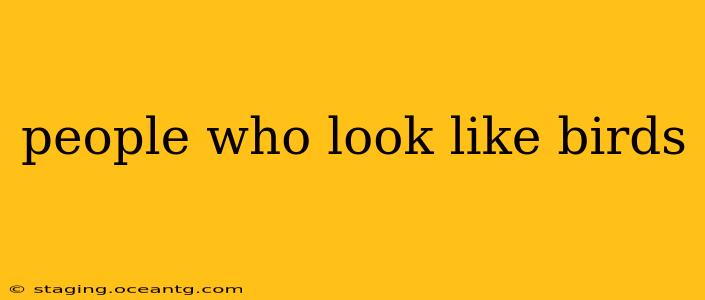The phrase "people who look like birds" evokes a range of interpretations, from fantastical creatures in mythology to individuals who adopt avian-inspired fashion or makeup. This exploration delves into the multifaceted meanings behind this phrase, examining its presence in art, fashion, and the intriguing ways human perception connects us to the natural world. We'll also address some common questions surrounding this intriguing topic.
What are some examples of people who look like birds in art and media?
Throughout history, artists have depicted human figures with avian characteristics, often symbolizing freedom, spirituality, or a connection to the divine. Think of ancient Greek mythology, where figures like Icarus famously donned wings and soared through the air. More recently, fantasy and science fiction have embraced the concept of people with bird-like features, often incorporating elements of magical realism. These depictions often use exaggerated features such as beaks, feathers, or wings to create a striking visual effect, highlighting the imaginative possibilities of combining human and avian forms. Examples can be found in various forms of media including paintings, sculptures, films, and video games.
Are there people with bird-like features due to genetic conditions?
While there aren't known genetic conditions that directly result in people having prominent bird-like features, certain syndromes can involve facial features that might be subjectively interpreted as resembling those of birds. It's crucial to avoid sensationalizing or stigmatizing individuals with such conditions. Any perceived resemblance is largely based on subjective interpretation and should never be used to label or otherize individuals. Medical professionals carefully diagnose and treat individuals based on established clinical criteria.
What about people who dress up as birds for cosplay or fashion?
Cosplay and fashion offer fantastic avenues for creative self-expression. Many people choose to dress in elaborate costumes or outfits inspired by birds, utilizing feather-like materials, beak-shaped accessories, or avian-inspired color palettes. This form of self-expression isn't about literally looking like a bird but rather channeling its visual essence for artistic or personal reasons. It's a fascinating example of how humans use visual elements to convey emotions, ideas, and even personal narratives. The creativity involved highlights the human capacity to connect with and reinterpret nature through various art forms.
How does the human perception of birds influence this interpretation?
Our perception of birds often influences how we interpret someone's resemblance to one. Cultural associations and personal experiences shape our understanding of what constitutes a "bird-like" appearance. For example, some might associate slender frames and long necks with birds, while others might focus on eye shape or color. This subjective interpretation underscores the complex interplay between human perception, cultural context, and the artistic or stylistic choices that shape our perceptions.
What does it mean to say someone "has a bird-like quality"?
Sometimes, the phrase is used figuratively to describe a person's personality or mannerisms. Someone might be described as having a "bird-like" quality if they are perceived as agile, quick-witted, or free-spirited. This metaphorical use reflects the common cultural associations of birds with these characteristics. It's a testament to the power of metaphor to convey complex human characteristics using symbolic representations from the natural world.
Conclusion: A Flight of Fantasy and Fact
The notion of "people who look like birds" encompasses a wide range of interpretations, from literal depictions in art and fiction to figurative expressions of personality traits. While genetic conditions might present with features that some might subjectively associate with birds, it’s important to approach this topic with sensitivity and avoid harmful generalizations. Ultimately, the phrase highlights the fascinating intersection between human creativity, perception, and our enduring connection to the natural world.
